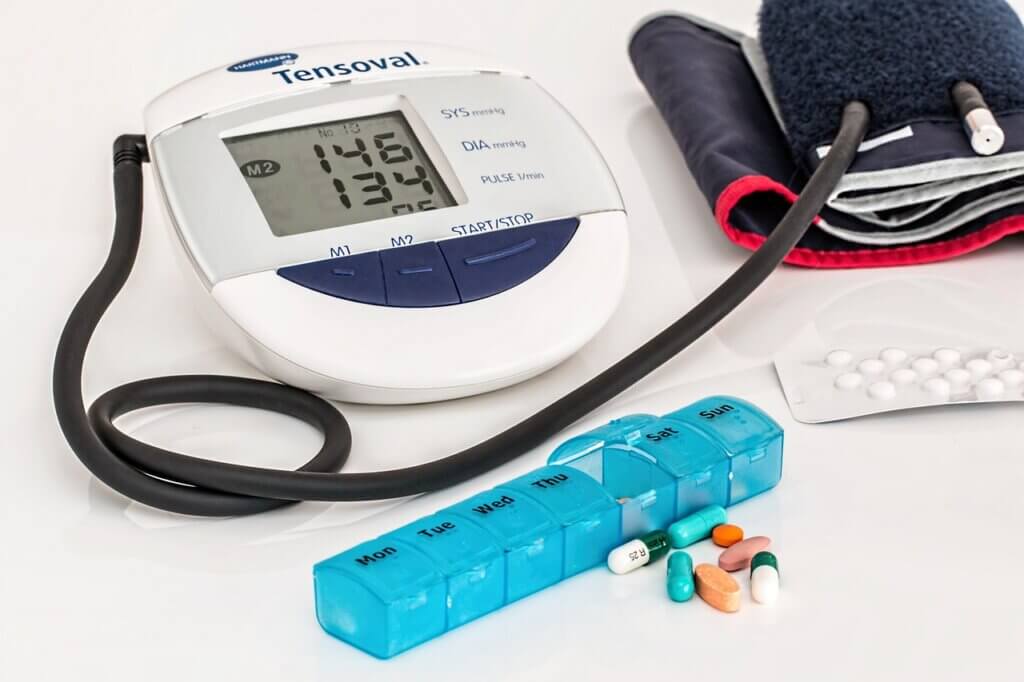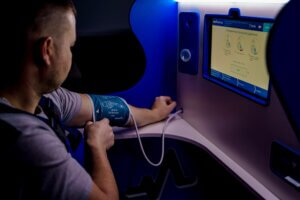After reading this article, you’ll:
- Grasp the critical role of mHealth apps in managing hypertension, including their capabilities to track health metrics, improve medication adherence, and offer personalized health education and lifestyle guidance.
- Recognize the challenges and considerations involved in the development and adoption of mHealth apps for hypertension, such as privacy concerns, accessibility issues, and the need for integration with broader healthcare systems.
- Appreciate the future potential of mHealth apps in transforming hypertension management through advancements in wearable technologies, integration with digital health platforms, and the application of AI and predictive analytics to offer more proactive and personalized care.
 Hypertension, defined as high blood pressure, is an increasingly prevalent health condition that affects over one billion people globally. Characterized by chronic elevated blood pressure in the arteries, hypertension is a major contributor to risks of stroke, heart attack, kidney failure, and other cardiovascular diseases. Though often asymptomatic, hypertension must be actively managed day-to-day through medications, lifestyle changes, and ongoing monitoring in order to mitigate these long-term health risks.
Hypertension, defined as high blood pressure, is an increasingly prevalent health condition that affects over one billion people globally. Characterized by chronic elevated blood pressure in the arteries, hypertension is a major contributor to risks of stroke, heart attack, kidney failure, and other cardiovascular diseases. Though often asymptomatic, hypertension must be actively managed day-to-day through medications, lifestyle changes, and ongoing monitoring in order to mitigate these long-term health risks.
Mobile health (mHealth) applications have recently emerged as an effective tool to help both patients and providers better manage chronic conditions like hypertension. These smartphone, web, or tablet apps can empower patients to self-monitor relevant health metrics, provide education, set reminders, and maintain communication with a care team. Within hypertension, mHealth apps are especially useful for tracking blood pressure readings, medication adherence, diet and exercise, and related data that provides insights about daily management.
The number of hypertension apps has exponentially grown, mirroring increasing smartphone use and digitalization of healthcare tools for chronic disease patients. With continued development addressing patient privacy, accessibility, and validation of their effectiveness, mHealth apps show high promise to positively impact outcomes. They serve as a convenient extension of traditional clinical care plans to enable patients better self-manage hypertension day-to-day. This article dives into mHealth apps and their impact on patients with hypertension.
Understanding Hypertension
Hypertension is defined by the American Heart Association as blood pressure higher than 130/80 mmHg. Though not an illness in itself, chronic hypertension directly correlates and contributes to higher incidence of stroke, heart disease, heart failure, kidney disease, and metabolic disorders. In the U.S. alone, nearly half of adults have high blood pressure. Globally, over one billion individuals suffer from hypertension, with the prevalence continuing to rise along with increased lifespans and rates of obesity and diabetes.
Development of hypertension stems from both genetic and lifestyle factors. Controllable causes include being overweight, physical inactivity, tobacco use, diabetes, high sodium intake, excessive alcohol consumption, high cholesterol, and chronic stress. Non-modifiable risk factors involve family history, age, and race. Secondary hypertension can also arise from kidney abnormalities, endocrine disorders, medications, or complications during pregnancy among other underlying medical causes.
Despite being a common condition that is easily diagnosed, hypertension remains challenging to sufficiently control long-term. Medication compliance is difficult for patients, with complex multi-drug regimens and side effects deterring consistent adherence. Lifestyle changes in diet, exercise, and unhealthy behaviors prove similarly difficult to implement and maintain by patients over time. Stress also induces biological responses that may directly increase blood pressure acutely. Consequently, only about 1 in 4 adults with hypertension have the condition under control. Improved chronic disease management solutions are imperative to target such barriers to better control hypertension.
The Rise of mHealth Apps
Mo bile health applications utilize smartphone and wearable technology to support personalized health management and medical delivery. mHealth encompasses hundreds of thousands of apps and digital tools targeted at wellness promotion, disease prevention and monitoring, diagnosis services, treatment support systems, data analytics, and care provider communication.
bile health applications utilize smartphone and wearable technology to support personalized health management and medical delivery. mHealth encompasses hundreds of thousands of apps and digital tools targeted at wellness promotion, disease prevention and monitoring, diagnosis services, treatment support systems, data analytics, and care provider communication.
Widespread smartphone adoption has driven exponential growth of mHealth apps among providers and patients alike over the last decade. These apps are revolutionizing healthcare delivery by enabling virtual care, telemedicine, and remote patient monitoring to supplement traditional in-person services. mHealth tools further empower patients to actively self-manage chronic conditions day-to-day, tracking health metrics, referencing educational content, and communicating with care teams.
For patients coping with lifelong conditions like hypertension, mHealth apps address common barriers to condition management between doctor visits and strengthen a patient’s ability to control their health. Features like medication reminders, blood pressure tracking logs, diet analysis, and patient education resources improve daily adherence to treatment plans.
Data visualization helps identify lifestyle triggers and patterns for high blood pressure over time. Two-communication facilitates care coordination and quicker responses to worsening symptoms. Evidence shows utilizing mHealth technologies significantly lowers blood pressure on average among hypertension patients. If privacy concerns, accessibility issues, and lack of standardized quality measures can be further addressed within the evolving mHealth landscape, such virtual tools will drastically improve outcomes.
How mHealth Apps Can Help Manage Hypertension
mHealth applications provide several key functions that empower patients to better control high blood pressure. Apps allow for self-monitoring by easily tracking blood pressure readings manually or automatically from connected wireless cuff devices. This facilitates more regular measurement rather than solely at doctor visits, building comprehensive logs. Patients can also document potential lifestyle triggers, medications taken, symptoms, and appointments. Setting reminders and alarms for prescriptions adherence or health tasks like exercise establishes positive routines.
Many apps integrate educational modules that provide content about hypertension, related health risks, treatment guidelines, and prevention through diet and lifestyle adjustments. Interactive features like quizzes, videos, and daily health tips promote patient learning and ongoing engagement with the app. Other programs incorporate progress dashboards, data graphs, and visual trends on blood pressure to provide insights over time. This self-awareness through mHealth encourages the small, daily actions that reduce risks.
mHealth apps enable direct messaging with care providers and give access to curated health resources for reference between in-person appointments. Patients can send blood pressure logs and quick questions, troubleshooting worsening readings or side effects from medications via patient portals. Such functionality improves chronic disease management through ongoing communication, course correcting issues promptly, and coordinating care regimen changes faster.
Benefits for Treatment Adherence and Lifestyle Changes
mHealth apps provide invaluable assistance to overcoming patient barriers to medication compliance and adoption of lifestyle changes. App reminder alerts make regularly taking prescriptions on time simpler amid busy schedules. These prompts also provide positive reinforcement to establish healthy routines. For managing complex treatment plans, apps can automatically refill medications and enable syncing across multiple health portals for accessibility.
Diet and exercise modifications represent essential non-pharmaceutical methods to lower blood pressure. mHealth apps collect inputs like nutrition logs, body metrics, and fitness activity to give interactive feedback on progress. Content offers healthy recipes, exercise demonstrations, and wellness advice as well. Gamification components–award badges, trophies, and point rewards systems–boost user motivation. Over time, small tweaks driven by app use accumulate measurable improvements.
mHealth engagement encourages a constant sense of accountability to intentional health behaviors that prevent hypertension exacerbations. App dashboards provide visibility over how completing daily goals produces data reflecting positive trends. By participating in their own care management through tracking, education, and communication mHealth enables patients to feel empowered pursuing a healthy lifestyle.
Benefits for Improved Monitoring and Insights
 The ability for continuous tracking of blood pressure readings is a major advantage mHealth apps provide patients. Whereas doctor visits may only record blood pressure monthly or quarterly, patients can self-monitor daily or multiple times per day. This high frequency data, documented over long periods, gives a much more accurate picture of overall trends and control. Additional metrics like diet, symptoms, and medication intake can be logged in correlation as well.
The ability for continuous tracking of blood pressure readings is a major advantage mHealth apps provide patients. Whereas doctor visits may only record blood pressure monthly or quarterly, patients can self-monitor daily or multiple times per day. This high frequency data, documented over long periods, gives a much more accurate picture of overall trends and control. Additional metrics like diet, symptoms, and medication intake can be logged in correlation as well.
Sophisticated mHealth apps analyze the self-reported data through interactive graphs, charts, and timelines. These visualizations help identify individual triggers that influence blood pressure like diet sodium intake, stress, or missed prescriptions. Patients gain personalized insights about optimal times of day or cyclical patterns that accompany hypertension control challenges. Over time, extensive data paints a comprehensive profile of one’s condition.
Collected patient data and generated reports may also be shared electronically with care providers. This facilitates better assessment of hypertension progression, adjusting treatment plans accordingly with the patient. It also enables accountability through visibility by doctors over patient adherence and responses. The convenience of virtual communication supplements in-person visits with value-added digital touchpoints.
Challenges and Considerations of mHealth Apps for Hypertension
While offering immense potential benefits, integrating mHealth technologies into medical practice faces obstacles around privacy, accessibility, provider integration, and financial sustainability. mHealth apps rely on collecting personal health information, raising valid privacy concerns, especially as data breaches grow prevalent. Misuse of patient data also presents risks. Ongoing cybersecurity developments and enforcement of ethical data use policies are instrumental to address this barrier.
Considerable disparities also emerge on mHealth accessibility and digital literacy across socioeconomic status and age demographics. Solutions must focus on sufficient patient training resources in using apps while designing intentionally inclusive user interfaces. Cultural and language barriers also affect adoption for minority groups. Moving forward, research around optimizing mHealth app utility for diverse users is critical.
Beyond patients, physician skepticism and lack of technical fluency hinders recommendation of apps into care regimens. Clinician guidance represents the most trusted source for patients considering mHealth tools. Overcoming physician doubts through internal digital health training and accumulated evidence confirming mHealth efficacy will accelerate integration.
Undefined reimbursement and regulatory approval pathways impede the mHealth industry. While FDA has expedited vetting health apps, navigating policy bureaucracy and insurance coverage represents hurdles to widespread legitimacy. Government and commercial payers lag on incentives for doctors and patients to utilize clinically-validated mHealth therapies.
Developing mHealth Apps for Hypertension
The exponential growth of mHealth apps offers tremendous potential to transform hypertension management but requires deliberate design considerations to maximize patient benefits and clinical outcomes. When developing hypertension apps, core functionalities should capture rich longitudinal data through connected devices for remote monitoring, provide context through education and visual data interpretations, and enable streamlined communication with care providers.
To drive continuous user engagement, apps must deliver tangible value readily through intuitive and rewarding experiences. Gamification elements that make progress tangible help sustain motivation. Technology integrations across multiple touchpoints–like wearables and EMRs–also improve convenience and visibility over health changes. Apps promoting realistic goal setting and accountability through sharing tracked results with clinicians yield the highest patient retention.
Because mobile apps enable regular self-care in a patient’s natural environment, they can identify individualized triggers and trends more sensitively than clinical visits. Passive data collection through sensors and tracking lifestyle contexts around blood pressure entries enhances these insights. Algorithms distilling patterns further personalize feedback and interventions specific to an individual’s fluctuating health status.
Approaching hypertension management through mHealth necessitates a patient-centered design mindset with customization and simplifying complex treatment regimens. Centering end user needs and perspectives is instrumental to overcoming barriers to sustained adoption. Co-creating solutions with patient input maximizes clinical validity and long-term utility. With thoughtful development targeting inclusiveness, privacy, and interoperability with emerging digital health infrastructure, mHealth promises substantially better hypertension control.
Working with an App Developer on a mHealth App for Hypertension
For healthcare providers and organizations seeking to create a clinically validated mHealth solution for hypertension patients, partnering with a specialized app developer offers invaluable expertise. A reputable mobile health developer understands integrating evidence-based treatment guidelines and behavior change best practices within user-friendly app experiences. They also provide strategic guidance on vital but complex considerations around data security, scalability, and regulating compliance.
Collaborating cross-functionally, providers contribute crucial medical oversight ensuring clinical validity while developers handle technical build and optimization. Beginning with aligning on intended outcomes, both parties iteratively design an intuitive patient journey addressing core patient and provider needs.
Customizability represents a key advantage of mHealth apps over generalized wellness products. Developers enable personalization for medication scheduling, health metric thresholds, education priorities, and various permission settings. White label mobile apps easily configure to specific care programs, a health system’s brand, and visual identity. Over time, analytics visibility helps pivot offerings to user segments with varying levels of condition severity.
As digital health interoperability standards progress, developers must also architect flexible integrations with complementary platforms like wearables, EMRs, and telehealth. Approaching mHealth solutions holistically within emerging health tech ecosystems maximizes convenience and connectivity. Such partnerships between medical and tech experts enhance possibilities for transformative mobile health innovations.
The Future of mHealth Apps for Hypertension
As mHealth apps continue proliferating, significant opportunities exist to maximize impact for hypertension patients through emerging technologies. One area of rapid innovation involves wearable biosensors and connected devices that passively gather health metrics without manual entry. These include digital blood pressure bracelets, EKG/heart rate trackers, and ingestible sodium intake sensors. Seamlessly capturing such data 24/7, analyzed by machine learning for insights, will enrich mHealth efficacy.
Integrating mHealth functionalities across multiple digital health platforms also streamlines accessibility and utility. Apps linking with patient electronic medical records, telehealth platforms, and health system patient portals unify chronic disease management. Cross-platform accessibility with auto-populated data facilitates holistic analysis by care teams and personalization of interventions.
Finally, artificial intelligence (AI) and predictive algorithms will revolutionize future mHealth apps. Personalized AI assistants can provide tailored guidance and notifications, anticipating individual needs based on learned routines and preferences. Predictive analytics applied to diverse health data may also forecast hypertension risk trajectories and recommend preemptive treatment adjustments through precision insights. Such functionality moves mHealth apps beyond reactive treatment support towards optimized and eventual preventative solutions.
With hypertension impacting over one billion globally, scaled adoption of digitally-empowered, evidence-based mHealth apps can dramatically alleviate its debilitating complications and costs. Their promise to augment routine care through daily personalized support is increasingly within reach through ongoing technological and collaborative advancements between patients, developers, and healthcare providers.
Frequently Asked Questions (FAQs) about mHealth Apps for Hypertension Management
1. What are mHealth apps, and how do they assist in managing hypertension?
mHealth apps are mobile applications designed to support health and wellness, particularly for managing chronic conditions like hypertension. These apps enable patients to self-monitor their blood pressure, track medication adherence, log diet and exercise activities, and maintain communication with their healthcare providers. By providing tools for daily management and insights into health patterns, mHealth apps empower patients to take control of their hypertension and make informed decisions about their health.
2. What features do mHealth apps for hypertension typically offer?
mHealth apps for hypertension commonly offer a variety of features aimed at supporting patients in managing their condition. These features include blood pressure tracking logs, medication reminders, dietary analysis, patient education resources, data visualization for identifying lifestyle triggers, and two-way communication with healthcare providers. These functionalities help patients adhere to their treatment plans and make lifestyle adjustments that contribute to better blood pressure control.
3. Are there any privacy concerns associated with using mHealth apps for hypertension?
Yes, privacy concerns are a significant consideration when using mHealth apps, as these applications collect and store sensitive personal health information. Users should ensure that the app they choose employs robust security measures to protect their data from unauthorized access or breaches. Developers and providers must adhere to stringent data protection regulations and ethical guidelines to maintain user trust and safeguard privacy.
4. How do mHealth apps for hypertension improve medication adherence and lifestyle changes?
mHealth apps improve medication adherence by setting reminders and alerts for patients to take their medications as prescribed. They also support lifestyle changes by allowing users to log dietary intake and physical activity, offering feedback on progress, and providing access to educational content on healthy living. Gamification elements and interactive tools further motivate users to adhere to their treatment plans and engage in behaviors that lower blood pressure.
5. What is the future of mHealth apps in hypertension management?
The future of mHealth apps in hypertension management looks promising, with advancements in wearable technology, AI, and predictive analytics expected to enhance their effectiveness. Wearable devices will provide continuous, passive monitoring of vital health metrics, while AI and predictive algorithms will offer personalized guidance and anticipatory adjustments to treatment plans. Integration with digital health platforms will also streamline care coordination, making mHealth apps a central component of comprehensive hypertension management strategies.





